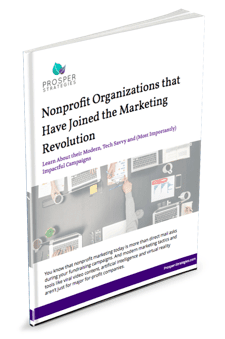Video is everywhere and it’s not going away anytime soon. Here are some numbers to prove it:
- According to Google, six out of 10 people would rather watch online videos than television.
[spacer height=”5px” id=”4″] - Hubspot estimates that 78 percent of people watch videos online every week, and 55 percent watch videos every day.
[spacer height=”5px” id=”4″] - A Facebook executive went so far as to predict that their platform will be all video — and no text — in the next couple years.
[spacer height=”5px” id=”4″] - Mobile video viewing doubles every year.
Video can be particularly powerful for nonprofits. A Google study found that 57 percent of people who watch a video go on to make a donation.
But it’s not enough to simply upload some footage from an event or post a text-based video on your YouTube channel and hope people will watch. The secrets to creating strong videos for nonprofits include sharing engaging stories about your impact, letting the people you serve tell their own stories, turning your impact report into an engaging narrative and using the right platforms to share the videos you create.
Show, don’t tell your stakeholders about your impact
Explaining what you do is one thing, but showing how your organization makes a difference with video can be even more powerful.
One very strong example of this is Charity: Water’s “virtual reality” experience they shared at a black-tie fundraising gala in 2016. Each attendee was given a headset and was shown an immersive video story of a 13-year-old girl and her family getting clean water for the first time. Because this video very clearly drew a line directly from donations to impact, donors contributed $2.4 million to the organization in one night, far surpassing donation goals. You can view that video here.
Let the people you serve tell their own stories
Every single person you serve has their own unique story that led them to your organization, their own strengths and their own goals for the future. That’s why it’s so important to let them share who they are in their own words. Not only is this empowering for the people you serve, but it can also inspire people to support your cause.
At Prosper Strategies, when creating videos for our clients, we don’t provide scripts for participants to read from or feed them lines. We simply ask questions that allow the people we feature to tell their own stories in their own way, sharing what an organization has meant for them and how it has allowed them to reach their full potential.
Tell a visual story with your annual impact report
Many organizations today are doing more with their annual impact reports than creating written documents. They’re building strong, visual stories with graphics and photos, and some are even sharing that information with dynamic videos.
If you host an annual fundraising event or gala for your donors and supporters, this is a great opportunity to share your visual impact report. Not only does it show your supporters exactly how they’ve contributed to your mission over the year, but it can encourage them to continue or expand their support.
Use the right platforms to share your stories
It can be tempting to share every video your organization creates across every one of your social media platforms in addition to your website. However, it’s important to share different versions of videos where they will be most effective.
Facebook and instagram are better for sharing short-form videos that are less than three minutes long. Longer videos that you share during events and host on your website can also be added to your organization’s YouTube or Vimeo channel and linked to within email messages to your supporters.
Helpful tips for every video
A lot of resources are required to create a compelling video. In addition to raw footage, the most compelling videos often require voiceovers, graphic design, music and a strong editor to craft the perfect visual story to share with your audience. To ensure you’re using all of those resources most effectively, we recommend:
- Grabbing your viewer by making the point of the video clear within the first three to five seconds.
[spacer height=”5px” id=”4″] - Including a strong call-to-action in every video, whether that’s to donate, volunteer, or take action in another way like calling a representative, taking a pledge, or signing a petition.
[spacer height=”5px” id=”4″] - Making the video accessible for all audiences by including closed captions in multiple languages, audio descriptions and interactive transcripts.

In our resource, we lay out a few examples of nonprofit organizations that have used cutting-edge tech and marketing techniques to engage their audiences on a deeper level.
